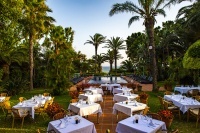Santa Catalina Castle
by Chris Chaplow and Fiona Flores Watson
Castillo Santa Catalina is an observation tower which was constructed in 1931 in the style of a 16th-century castle, on a small hill of the same name. The ‘castle’ has a large, strangely out-of-proportion observation tower with mudejar arches and balconies on the corners, and has become a much-loved symbol of Tarifa.
It occupies a strategic location overlooking the Mediterranean and Playa Chica, the causeway to Isla de los Palomas and the Atlantic Ocean, and Playa de los Lances.
The Castle of Santa Catalina is currently closed to the public, after an interesting and polemic life, although many hope it can be restored and reopened.
HISTORY OF THE CASTLE
The strategic Santa Catalina Hill has had a number of defensive constructions built on it throughout the ages. A 1567 drawing by Anton Van der Wyngaerde (a prolific Flemish topographical artist) shows a small chapel on the hill which is called ‘Santa Catalina y de San Telmo’.
In 1926 the Ministerio de Marina decided to build a flag-station for semaphore or optical telegraph (men holding signals) to communicate with shipping. Once the land was ceded from the town council, the plans changed and the current building was erected in 1930 and 1931.
During the Second World War the hill was fortified again,and a network of pillboxes and bunkers was constructed beneath and next to the castle which can be seen from the road.
The original design by Julio Murúa, in an Italian Renaissance style, was justified by the need to give the building a defensive appearance, but in harmony with the castle on the Isla de los Palomas and the Castillo de Guzman El Bueno. The interior was simple, in keeping with its military use: barracks, lookout, offices, and kitchen. It was not well-received locally at the time and became known as Castillo de Santa Catalina, even though it was never a castle. The building was opened in 1933 but the optical telegraph was never installed.
At the beginning of the Spanish Civil War, the building was the target of Republican bombing and suffered so much damage that it was abandoned and remained so for forty years.
RECENT HISTORY
In 1972 the castle was repaired and became the control centre for shipping in the Straits of Gibraltar, and a weather station for the Armada Española (Spanish Royal Navy) and later the Instituto Nacional de Meteorología (Spanish National Met Office). It was the most southerly weather station in mainland Europe.
In 2000 the shipping control centre moved to a more modern installation and the castle served briefly as a night-time lookout point for the Guardia Civil.
In 2001 ownership returned to the Tarifa Town Council and it was added to the list of Instituto Andaluz de Patrimonio Histórico for inclusión as B.I.C. (Bienes de Interes Cultural)
A project to create a visitor and exhibition centre was started in 2006, but work was soon stopped by court order due to the historic nature of the site. To be continued…
Location
Calle Segismundo Moret

